2017 Activity Report
March Activity Report
10 April 2018
Global Japan Office Coordinator
Taguchi Kazumi
The first item in the March London Report concerns the TUFS-SOAS friendship meeting.
The event is comprised of a presentation by Okano sensei and Shinagawa sensei, both of whom had been at SOAS as visiting scholars from last Autumn. After the academic presentation, Dr. Hughes, Professor Barnes and two SOAS students from the SOAS Minyo group joined us singing and playing music to celebrate the TUFS-SOAS friendship event.
As a coordinator, it was my responsibility to organise the event. I started preparing food to take to the event from 9 o’clock in the morning. I thought hard about a menu which would consist of cooked dishes that could be eaten when they are cold. I came up with the following menu: Inarizushi, cucumber rolls, eel & cucumber rolls, seasoned and boiled Daikon and carrot, Kinpira style sautéed burdock, salmon fishcake, and Taiwanese style deep fried pork.
After 8 hours of hard work, I managed to finish all the cooking by five o’clock and then headed to SOAS. On my arrival at SOAS, I received a phone call from one of the TUFS students who has been studying at the University of Westminster saying she got lost. We communicated with each other and arranged to meet up near the main building.
When we arrived at the venue, Okano sensei and Shinagawa sensei were finishing their preparations for the talk. They helped me to set up the table and lay out the food and drinks.
We waited for people to arrive and started the event around 5:45 p.m.
In attendance were three TUFS students studying at SOAS, one of two students studying at Westminster University (the other student wanted to come, but couldn’t attend as she had a busy schedule due to the fact she was leaving the UK the following week), one of two SOAS students who are going to study at TUFS from this Autumn, Dr. Nathan Hill (Head of the Japan Korea section of the Department of East Asian Languages and Culture) and Professor Screech (Professor of the History of Art) who has stayed and taught at TUFS in the past and had been invited by Okano sensei for this event as they were taking the same Burmese language class. Dr. Hughes, Professor Barnes and two SOAS students also joined us after their performance.
The event started off with Okano sensei giving a talk about his research on old Burmese language texts, their structure and how information was created in the archive using visual images.
His talk was followed by Shinagawa sensei presenting his research on the Bantu language. He explained the complicated relationship between regions and languages in Africa using language distribution maps, so that beginners could easily understand the topic.
After a short break, the SOAS Minyo group consisting of Dr. Hughes, Professor Barnes, a Japanese language fourth year student, and a music student, played some excellent Minyo music further adding to the excitement of the event.
Dr. Hughes and Professor Barnes also played some fantastic Okinawan music in the folk tradition. I also sang two tunes from the Okinawan classical tradition.
To close the event, we played a celebratory tune called Iwai-bushi, in the hope that academic and cultural exchange between TUFS & SOAS keep growing in the future. It was a splendid way to end the friendship event for 2018, I am so grateful to the people who collaborated and the people who attended the event. Thank you so much everyone.
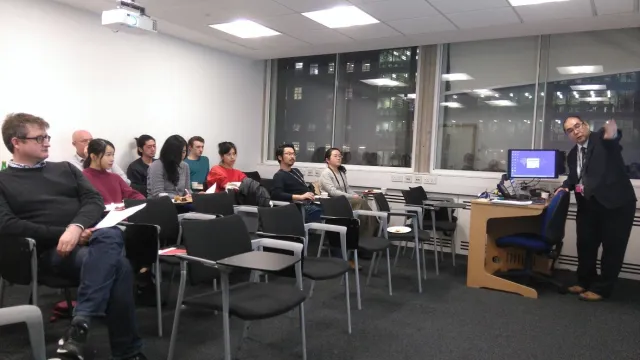
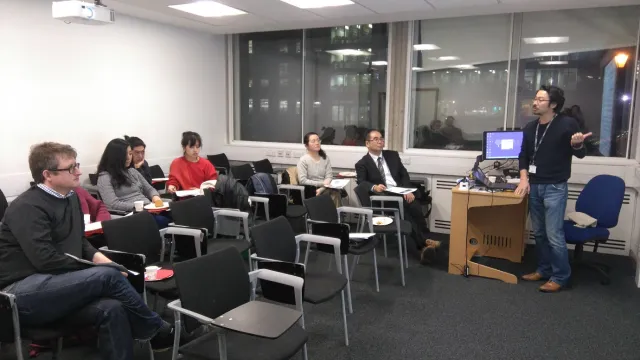
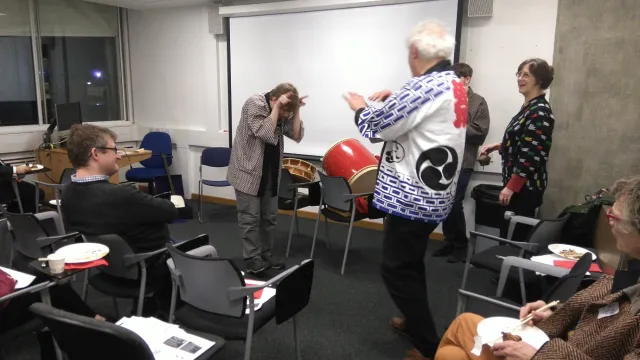
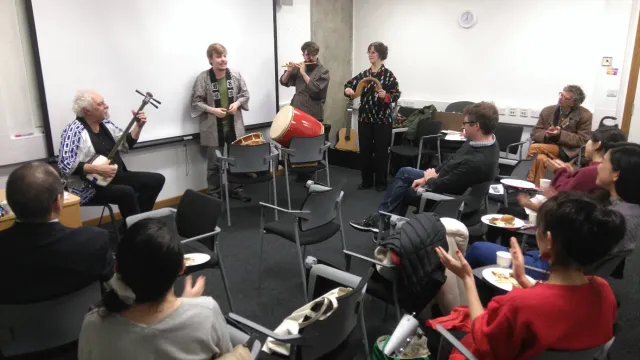
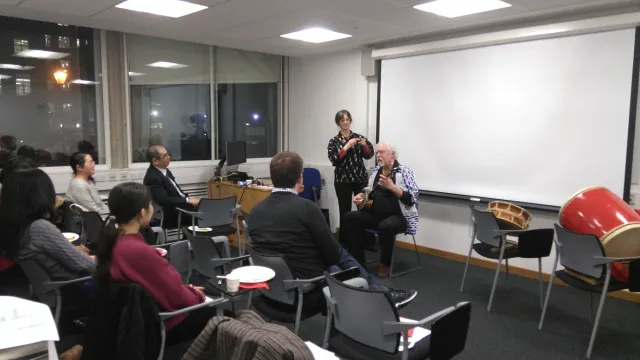
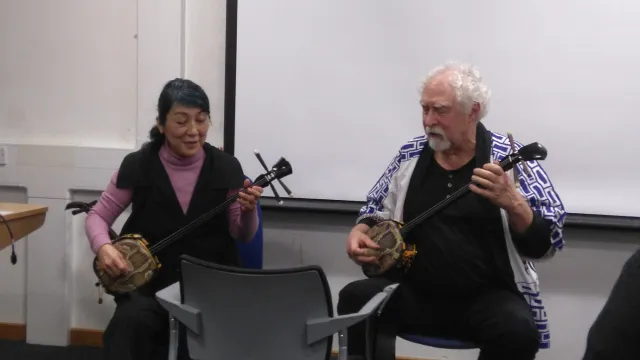
The second item in the report of this month is about the playwright, theatre director and leader of the theatre company Aokirimikan), Ms. Yuki Kanome who has been staying in London as she was selected as a researcher of the Japanese government’s programme of overseas studies for upcoming artists. The coordinator, Ms. Akiko Sato invited me to the play reading at the Club Room of the Cornet Theatre situated in the heart of Notting Hill Gate (this theatre was used in the well-known film, Notting Hill). I was lucky enough to witness both the rehearsal and the actual reading in front of an audience.
Ms. Kanome has received many prizes related to the theatre in Japan in the past. I got the impression that her visit this time is a step towards introducing and developing her talent at a global level.
For the preparation of the reading of the play, Ms. Kanome joined the theatre translation workshop at SOAS given by Dr. Nozomi Abe, who gives workshops periodically at a class called Translation Studies and Japanese. Dr. Abe is also the translator of the play that Kamome put on at Club Room.
The short play was called Ikenai (English title: Forbidden), and it has a minimalist setting of two actors, one table, one chair and a glass of water.
To summarise the short play, a man who has been living earnestly following rules has been forbidden to drink the glass of water on the table. He comes across a mysterious woman who seems to know all about his past. By talking to the man, she provokes him to break the rule to drink the water. He finally breaks the rule, drinks the water from the glass and collapses on the floor.
The actors were a male actor of Japanese parentage and a Singaporean actress. Their acting was passionate and well-crafted and penetrated the audience’s heart. It was a short play, but a very deep experience indeed.
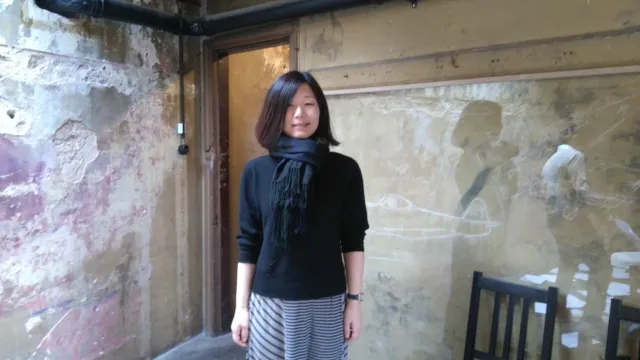
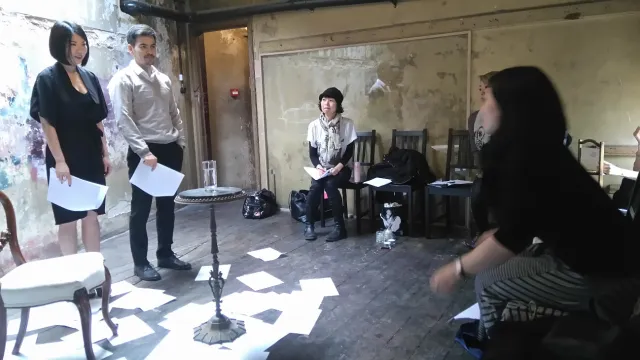
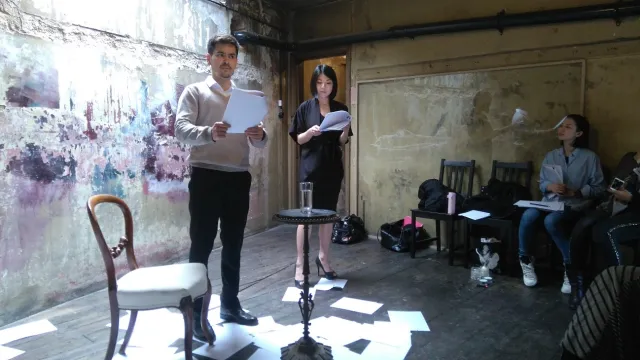
February Activity Report
5 March 2018
Global Japan Office Coordinator
Taguchi Kazumi
In this month’s report, I would like to write about the ceremony in which Dr. Hughes (TUFS-CAAS Unit2015) was awarded The Order of the Rising Sun, Gold Rays with Rosette honour at the Embassy of Japan in the UK, London.
The ceremony took place in a big hall in the embassy which is situated opposite St. Jame’s Park and near Buckingham Palace. It was a grand event. The Ambassador Extraordinary and Plenipotentiary, the ambassador’s wife, Dr. Hughes and his wife, Professor Barnes, welcomed the guests at the entrance hall. The Japanese ambassador and Dr. Hughes were both wearing Montsuki Hakama, the formal traditional Japanese costume.
The ambassador began the ceremony by introducing Dr. Hughes. Then, Dr. Hughes was presented with the medal of The Order of the Rising Sun, Gold Rays with Rosette honour by the ambassador. Receiving the order of the Rising Sun is in recognition of Dr. Hughes’ continuous effort towards introducing and promoting Japanese culture to everyone without discrimination everywhere he has been. It is an acknowledgement on the part of the Japanese country to the contribution Dr. Hughes has made to the promotion of Japanese culture.
The great hall was filled with guests who came to celebrate Dr. Hughes’ achievement. There were many people from SOAS as well, of course. After the ceremony, a performance was given by the Min’yo group and London Sanshinkai. Dr. Hughes set up and was responsible for leading these groups’ activities for many years. The award ceremony ended with huge excitement and a merry atmosphere. It was an amazingly relaxed mood in the embassy, which many of us had never experienced before and reflected Dr. Hughes’ friendly character. It was a wonderful experience indeed.
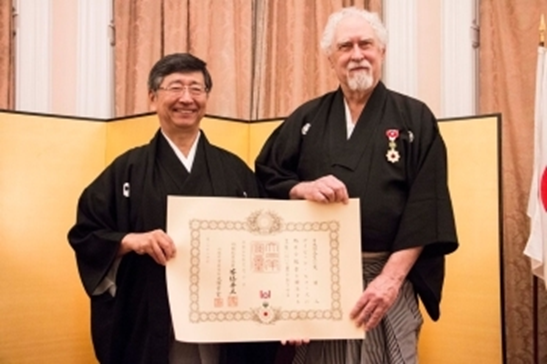
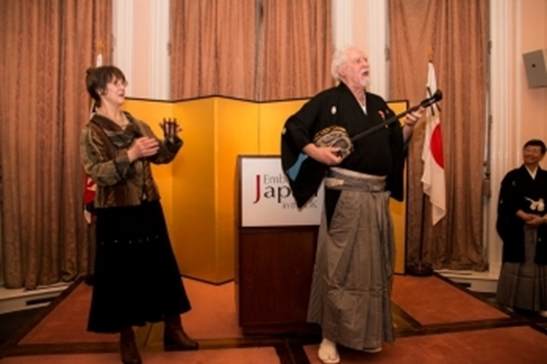
I was planning to report on a lecture on the Japanese language at SOAS. Unfortunately, it was cancelled due to the strike taking place amongst UK universities. It has been postponed until the next academic year.
Another event I would like to write about is the Student Tsugaru Shamisen concert.
I have mentioned the Tsugaru Shamisen player, Ichikawa Hibiki, several times in the past already. He teaches Tsugaru Shamisen and has many students in the UK and Berlin. The student concert is organised once a year and this is the fifth year. The event took place in a church in Finchley West in North-west London where there is a significant Japanese community.
A large number of students were featured from beginners to the very experienced. All of them performed Japanese folk tunes and sometime original tunes superbly. Many people also wore traditional Kimonos.
It is rare to have an opportunity to listen to students playing the Tsugaru Shamisen in Japan. There were nearly 30 students performing the Tsugaru Shamisen at that night’s event. The occasion began and ended with a group performance featuring all the participants, creating a powerfully combined sound of Tsugaru Shamisens around the entire church.
There was a highly energetic performance given by a female group calling themselves, Yosakoi London, who performed Yosakoi folk dance at the end of the first half. Yosakoi London was set up last year and this is their second show. Their act was on point and together demonstrating how hard they had been training. They are recruiting members at the moment.
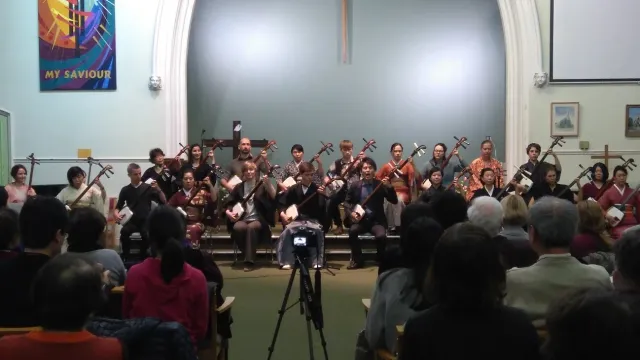
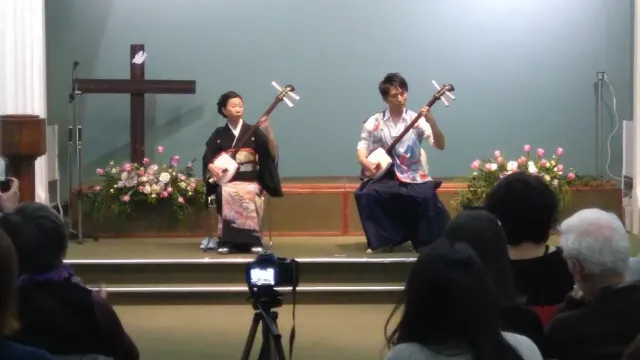
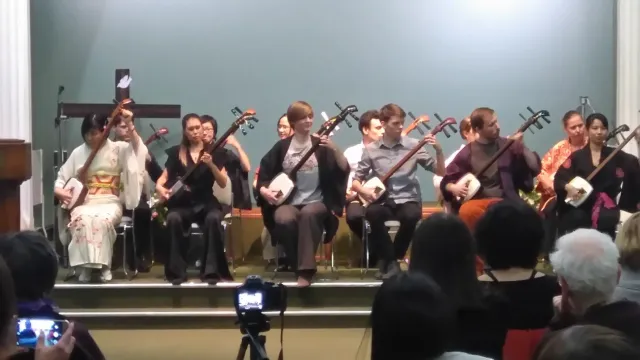
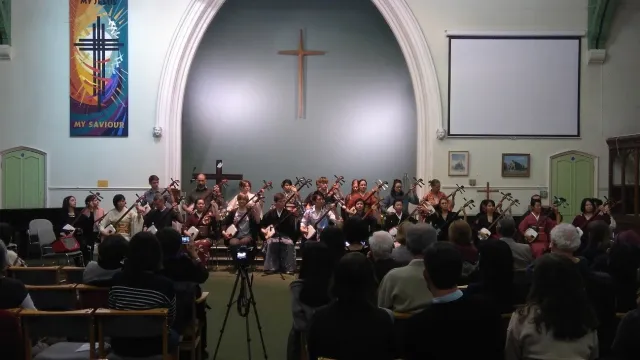
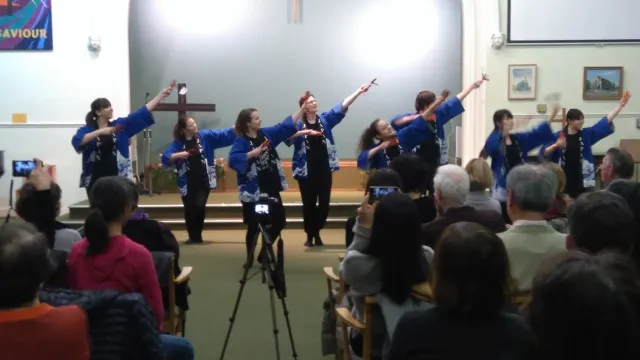
January Activity Report
5 February 2018
Global Japan Office Coordinator
Taguchi Kazumi
For the January London report I would like to write about a new year event organized by a mothers’ community in North London called JAMALNE (The Japanese Auspicious Mothers Association London North East, which may change to Totte Mum in the future).
This annual event started in 2010 in the house of one of the members. In 2013, it moved to a hired space in a nearby church and has been held there ever since. This year is the sixth anniversary and around forty families attended the occasion. I asked Ms. Kazuko Hohki who is the main organiser, about the background to this New Year event.
Ms. Hohki has been living in the UK for over forty years. After graduating from the University of Tokyo majoring in child psychology, she came and settled in London. Since then, she has worked as a performance artist, as well as writing, producing and acting in many plays of her own. Amongst them, “Toothless” and “Borrowers” which have been very popular and performed at many theatres. Ms. Hohki has also been involved in musical activities and is a leader of a performance group called “Frank Chickens”, which is mainly made up of Japanese women who in their appearances cover such genres as pop, rap and enka. The group was formed in the early 1980’s and has grown in number. They are still active today.
As well as being busy as a performing artist, Ms. Hohki is also the mother of a child, and this led to her establishing the North London Mothers’ community. I asked Ms. Hohki what was the reason for starting this event. Ms. Hohki told me it began with just her and another mother and child and then increased to a much bigger scale when Ms. Hohki, who has a lot of experience in organising and planning events, got in touch with other mothers.
It has been over 450 years since a social relationship was established between Japan and UK, and many Japanese have now made the UK their home. An increasing number of children have been born to couples of mixed Japanese and British parentage, and there are also many children of these second-generation Japanese. They are all part of the Japanese community in Britain.
Recently, in Japan, there have been issues of identity, of what makes a person Japanese. The number of Japanese who can be described as mixed race, who have one parent who is Japanese, has increased and so too has the number of Japanese who since childhood have been brought up outside Japan. As a result, Japanese communities outside Japan have diversified. The positioning and identities of these new type of Japanese communities outside Japan is an important issue in the development of an authentic Japanese global community.
The 2018 New Year’s event took place at the Baptist Church in North London about fifteen minutes’ walk from Seven Sisters tube station. After entering the building, there was a table set up for an Origami and Craft workshop where many children attentively watched a demonstration given by one of the mother/teachers. Children then tried hard to make their own creations under the instruction of the mother/teachers. It was a very exciting scene.
Opposite the workshop, was a table selling sushi. The sushi came from a shop called ‘Sushi Head’ which was opened about a year ago by a Japanese lady. It is very popular amongst Londoners, as the sushi is both affordable and tasty.
A children’s slide was set up in the next room and toys were also provided. It was a fun and creative atmosphere. Surprisingly, there was a table for a raffle. In one corner of the room a microphone and amplifier were set up in preparation for the performance, and chairs were in place for the audience. The entertainment consisted of Okinawan folk and classical music played by me, then Clive Bell who I introduced in the September report, played shakuhachi, shinobue, and a Thai instrument, the kane. The show ended with a performance by a duo, enka and min’yo singer, Akari Mochizuki and Tsugaru jamisen player, Hibiki Ichikawa.
Clive’s performance on shakuhachi and kane, Akari’s enka followed by Hibiki’s instrumental piece, ‘Tsugaru Jongarabushi’ and traditional folk music along with Akari’s singing were enough to take both children and adults back to a home inside their mind, in which they were mesmerised by the sounds. The finale of the 2018 New Year event was ‘Donpan Bushi’ a song which involved audience participation and which was received enthusiastically.
I would like to pay my gratitude to all the mothers who wore a happi coat and worked so hard to bring this event off. It was a valuable and fantastic new year’s experience of Japanese culture which is increasingly hard to come across in Japan nowadays.
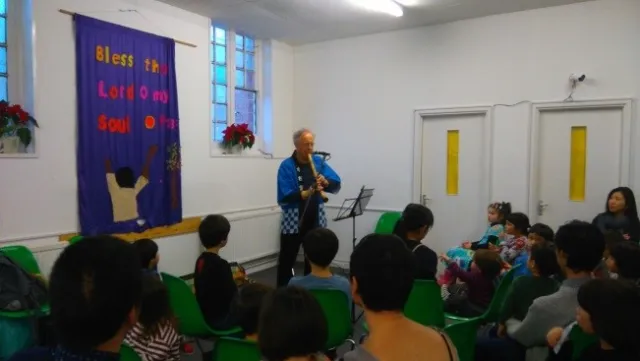
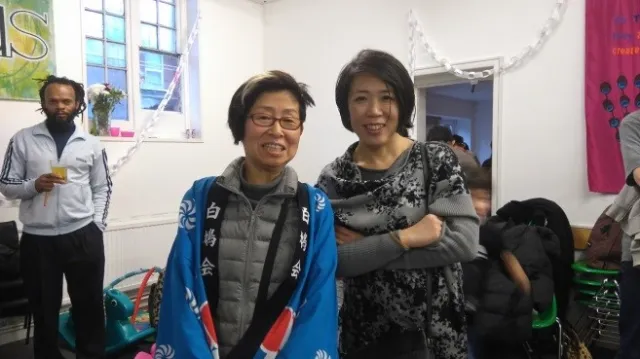
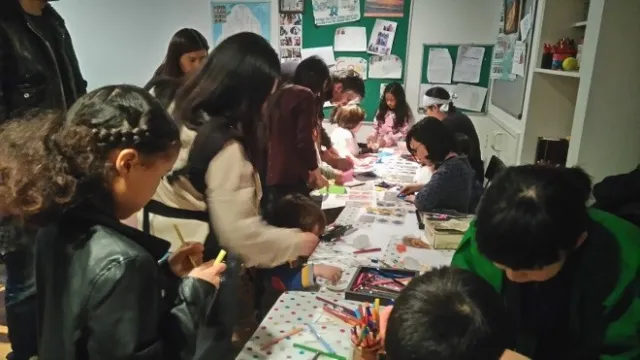
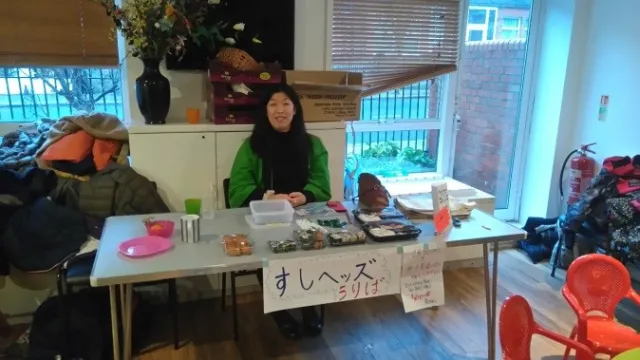
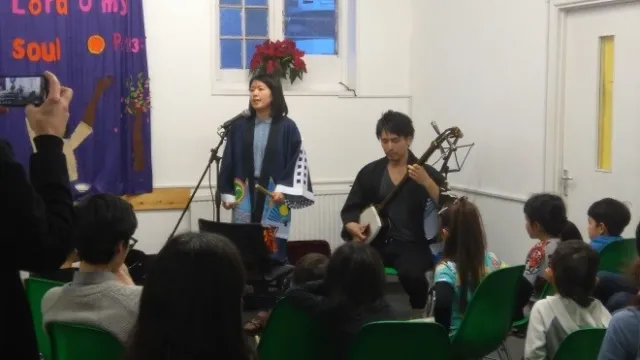
December Activity Report
5 January 2018
Global Japan Office Coordinator
Taguchi Kazumi
For the December report I would like to write about a class on modern Japanese literature that took place at SOAS.
The class was given by Professor Stephen Dodd. Professor Dodd has in the past visited and given a talk at the Tokyo University of Foreign Studies. So, some of you may already know him. He will be visiting Tokyo University of Foreign Studies from October next year as a visiting scholar. This report can be regarded as a preview of his teaching.
It is the final month of the year, during this period London is preparing for Christmas. The streets are bright with illuminations and decorations which transform the city into a fairy land. However, students still have to write and submit an essay before they go away for the Christmas break.
In the classroom, after checking the attendance of the students, Professor Dodd confirmed the submission deadline and the length of the essay. Despite the fact that it was getting so close to the essay deadline, the classroom was filled with over twenty students. Professor Dodd gave special permission for me to attend. I took a seat at the back of the classroom, so that I wouldn’t disturb the lesson.
Today’s class was a discussion of novels by two artists; “Machine” by Yokomitsu, Riichi and “A riot of goldfish” by Okamoto Kanoko. The class started off with a discussion of Yokomitsu’s work. Professor Dodd asked the class for their impression of the story.
The students raised their hands and one by one gave their impressions of the work. Among the reactions were: “violent novel”, “cycle of self-doubt and paranoia”, “don’t understand the meaning of the story or what it is about”, “it is passive, the boss is childlike and strange, giving an impression of being disconnected from the world of normality”, “people were avoiding reality”, “futuristic”, “a riddle”, “illogical”.
Professor Dodd responded to the comment of “illogical” by saying “but it is rational within the world they live in.”, after that, the discussion proceeded. Professor Dodd asked the class whether the story is typically Japanese or not.
One of the students asked “Who is in control?”. He said it seemed as if there was no ending, things just went around in a circle and he felt dissatisfied after reading the story.” Professor Dodd now asked, “What is the effect of the story? Does the novel make you feel disturbed or uneasy? Doesn’t it stimulate your thought patterns and make you think what makes you feel uncomfortable about the novel? Because the sense of unease cannot be pinned down to one point.”
The discussion developed further. Professor Dodd asked the students how they would relate the novel to the situation in Japan in the 1930’s. One student said, “It is a reaction against Naturalism. The characters are controlled by the machine. Everything is connected to science and chemistry.”
“Do you think this novel is modern literature?” Professor Dodd asked the class. The students hesitated to answer. Professor Dodd went on to explain. “The style of expression is the Japanese interpretation of Modernism. Immorality and ignorance are expressed through the thrill of violence and nonsense. But it is a different kind of violence to that seen in slapstick. Here, violence exists on its own. The author is expressing the time he is living in through this kind of depiction. He is being a kind of Zeitgeist of the time. For example, the way he writes sentences which go on and on rather than small sentences. The writer chose this strange writing style on purpose. In one sense, it can be said that there is a similarity with the Dadaist expression method in layout where the spaces are freely filled with sentences with different fonts and sizes, which randomly break with the traditional and ordinary writing method.”
Professor Dodd talked about the theme of machines in the novel. Among the comments were: “It is a criticism against fate and modernism.” Another student responded, “Under Capitalism, it is necessary for individualism to exist, and everything is designed in terms of individualism.”
Another question from Professor Dodd was, ‘What is the meaning of the individual?’ ‘What is the meaning of the machine?’ There are two alternative interpretations, he said, positive and negative. For instance, let’s think about artists who were creative during the Russian Revolution. One of the images created by Russian Constructivism was a positive image of a large machine moved by a cogwheel. Giving the idea of a new world created through machines. In contrast, one of the great films by Charlie Chaplin, ‘Modern Times’ expressed the negative image of mechanisation in a world where human-beings are driven to despair by machines.
The discussion on this topic had taken up more than half of the allotted time. It had to end at this point and move on to another theme. The subject matter was now “A riot of goldfish” by Okamoto Kanoko.
After taking a look at the characters in the novel, Professor Dodd asked for impressions on the protagonist. One student considered him to be an “escapist” another described him as being “self-pitying”.
Professor Dodd observed that the protagonist, Mataichi, has many ideas and desires. He now needs to take action, but he isn’t able to do so. This situation often occurs in Japanese novels for instance in a novel from the Meiji period titled “Ukigumo” by Futabatei Shimei. In this story, the protagonist doesn’t choose to act. However, in contrast, if we look at Russian novels, the protagonist often decides to take action.
One student said Masako, the daughter of his employer, was out of reach as a lover/partner because of class differences. They also thought the ending was very interesting. Another opinion was that “all the characters were leaving their fates to circumstances.”
Professor Dodd explained that we need to consider the settings of the novels. We have to imagine the 1930’s in Japan from a woman’s perspective. Although, there was a group propagating the women’s liberation movement, it wasn’t a leading movement of the time.
In 1937, Japan invaded Manchuria and began to expand into China. It was the beginning of expansion of Militarism.
Professor Dodd went on to say how Okamoto Kanoko was a Buddhist and that there are many scenes in her novels which feature flowers. This could be a reflection of Buddhist ideas.
One student said, “Masako, the supporting character is depicted as being very modern.” It seemed like the beginning of an interesting debate. But unfortunately, the class had to come to an end at this point. It had been an hour of rich discussion.
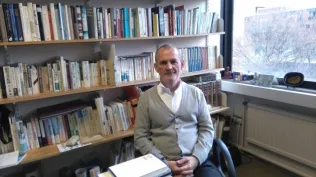
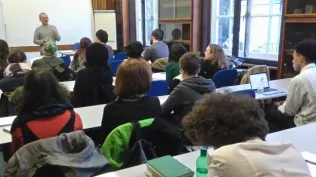
November Activity Report
30 November 2017
Global Japan Office Coordinator
Taguchi Kazumi
I would like to dedicate my November report entirely to my teacher, Dr. David Hughes, who you may know already from my past reports. He also taught at TUFS for one term in 2015 as a visiting scholar. In fact, Dr. Hughes and Dr. Iris Haukamp were the first lecturers sent from SOAS in 2015 to start the official TUFS-CAAS Unit project in Japan Studies.
I already wrote about his passion and contribution to teaching and promoting Japanese traditional folk music in the August report 2016 and of his dedication to Okinawan music in the July report 2017.
I am writing about Dr. David Hughes for this report, as this year Dr. Hughes received The Order of the Rising Sun, Gold Rays with Rosette honour issued by the Japanese Government.
In this report, I would like to share with you some of the contents from the press release issued by the Japanese Government.
“On 3 November 2017, the Government of Japan has announced the conferment of the Order of the Rising Sun, Gold Rays with Rosette on Dr. David W. Hughes, former Head of Department of Music, School of Oriental and African Studies (SOAS), University of London and former Chairman of the Center of the Music Studies, SOAS, University of London, in recognition of his significant contribution to promoting cultural exchange and mutual understanding between Japan and the United Kingdom.”
“Dr David Hughes has played a significant role in promoting understanding of traditional Japanese music, particularly folk music, in the UK. He has organised over 200 performances featuring visiting practitioners from Japan and has set up three groups in the UK that are at the forefront of teaching and performing Japanese music, alongside his significant academic achievements relating to increasing understanding of traditional Japanese folk music in the UK.”
“Throughout his extensive career, Dr Hughes has published a wealth of literature in Japanese and English on traditional Japanese folk music. Some of his most notable publications are Traditional folk song in modern Japan: sources, sentiment and society and The Ashgate research companion to Japanese music, the latter of which he co-edited.”
“Alongside his academic contributions, Dr Hughes has been a key figure in promoting Japanese traditional art forms to the wider public in the UK. He founded three groups which continue to this day: the SOAS Min’yo Group, the London Okinawa Sanshinkai and the SOAS Noh Group (which has subsequently become part of the University of London Noh Society). These groups successfully contributed to iconic key events including the 1991 Japan Festival and Japan 2001, as well as to Japan Matsuri in recent years. They not only give the public in the UK a unique opportunity to learn and perform a wide variety of Japanese arts but also make them more accessible by demonstrating them extensively around the country. In 2011 Dr Hughes received the annual Japan Society Award for “outstanding contributions to Anglo-Japanese relations and understanding” for his role in making traditional Japanese music better known among people in the UK.”
“Alongside these activities, he has also personally facilitated or contributed to numerous performances by Japanese traditional performers in the UK. At these events he often acted as an interpreter, translator or commentator so that audiences in the UK could come to understand the social context from within which the pieces had been created. It is no exaggeration to say that many people in the UK owe their exposure to Japanese music or performance art directly to Dr Hughes.”
“In light of these significant contributions to furthering the appreciation of Japanese folk songs and performance art in the UK, Dr Hughes well deserves to be honoured for his exemplary contribution to mutual understanding and the wider UK-Japan relationship.”
http://www.mofa.go.jp/mofaj/gaiko/protocol/jokun.html
Above is a link for further information.
In fact, I am a good example, as I am one of the lucky people who were introduced to and learnt many types of traditional Japanese music from Dr. Hughes: ranging from Noh, Kabuki, Bunraku, Gagaku, Japanese traditional folk, Okinawan classical and traditional folk music, Shakuhachi and Bon dance, right up to contemporary Japanese popular music.
I asked Dr. Hughes about his experience of teaching at TUFS. He replied as follows,
“Of course I’m very honoured to receive this award from the Japanese Government. Japan and its music have been the main focus of my career. And among my many chances to lecture about Japanese music around the world (in thirteen countries), one of my happiest experiences was teaching at TUFS for four months from October 2015.”
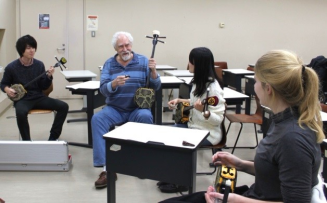
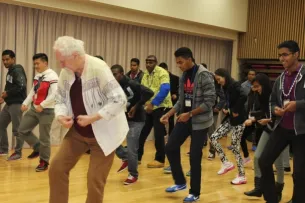
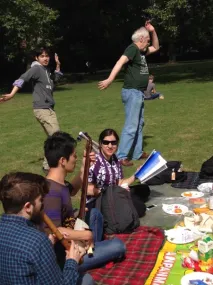
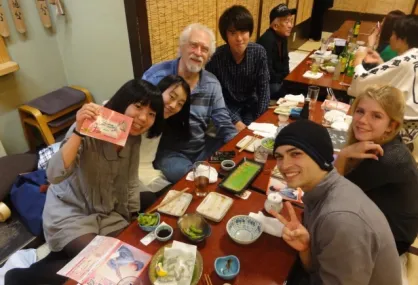
September Activity Report
11 October 2017
Global Japan Office Coordinator
Taguchi Kazumi
The first item in the September London report is about the Japan Avant-garde Film Festival, which took place at Kings College, University of London.
I went to see a silent film based on the novel “Mad person’s diary” (Jp. Kyojin Nikki) written by Kawabata, Yasunari, called “A Page of Madness” (Jp. Kurutta Ippeji) directed by Kinugasa, Teinosuke. The film was shown with a Benshi narrating the story and was accompanied by musicians playing live in the auditorium.
I have seen the same silent film with a newly composed recorded sound track in the past. I was excited about the fact that it came with a story teller (Benshi) narrating in English and doing live sound effects, as it would be a rare occasion to see the film in this context.
It is said that the tradition of silent film narrated by Benshi began in 1896 (Meiji 29) as a part of Taisho Modernism. There were a good number of Benshi active in those days as there was very little entertainment around. Nowadays in major cities such as Tokyo, Osaka and Nagoya in modern day Japan there are cinemas where they show silent films with Benshi narration. It is well worth checking it out, if you find the sound of it interesting.
The Benshi narration was performed by Tomoko Komura, who is very small but has an enormous power. Komura is a professional actress who plays all the characters by skillfully changing her voice to fit into the parts, as well as narrating the story. It sounds a little similar to the role of Gidayu in Bunraku tradition. However, the difference is that the puppeteer’s moves are dictated by the Gidayu chanter, whereas Benshi has to fit into the scenes which are developing. The Benshi’s performance is so smooth and natural it makes the story progress in such an authentic manner that you forget you are watching a silent film.
The embellishments for the floating Benshi narration were performed by three improvising musicians. Clive Bell who is a renowned Shakuhachi player and proficient on the mouth organ, Silvia Hallett who is an expert in improvisational music and played the violin, saw and electronics and Keiko Kitamura, who often features in Japanese Classical music ensembles, playing the Koto and doing voice improvisations. Each of them made the best use of their instrument and optimised the sound effects creating tension and appealing to the emotions.
The Japanese Avant-garde and Experimental Film Festival which organised this event was set up this year. Their major objective is in their words, “to draw connections between classic twentieth century Japanese avant-garde Cinema and contemporary Japanese experimental filmmaking. We provide a platform for these cinematic movements in order to bring them to a wider audience here in the UK. We encourage inclusivity, and propose to foster co-operative discourses between the practical/artistic, scholarly, and fan communities.” I hope they develop this project further and plan more events such as this which was very successful.
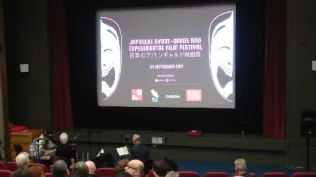
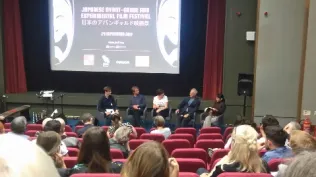
The second report of the month is about the Freshers Fair. The new academic year has begun and the campus is filled with new and old students finishing administrative procedures. A part of Senate House which was the headquarters of University of London has become SOAS premises, giving more space for societies to display their activities at the Fresher Fair.
I found a few unusual societies this year. Societies such as the Otaku (Nerd) Game Society and the Drag society! This gives the impression that anybody can form the society they want without any type of prejudice.
The Korean Drumming Society formed a procession which marched from indoors to the courtyard and ended up playing in front of the main door building. They created a welcoming festival atmosphere which made everyone happy.
I believe that SOAS students for yet another year will study hard and play hard!
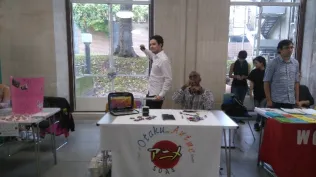
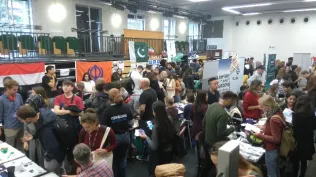
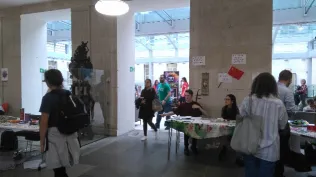
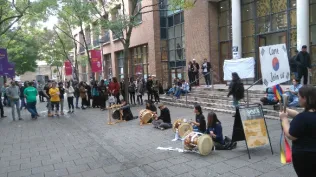
August Activity Report
5 September 2017
Global Japan Office Coordinator
Taguchi Kazumi
For the August report from London, I am going to write about two events. The first one is The World Athletic Competition which was held at the beginning of the month in the Olympic Stadium. The second one is the Noh Training Project which took place at the end of the month at Royal Holloway, University of London.
In this year’s athletic finals in London, the Japanese relay team for 100m x4 qualified for the final heat. This competition was also the final appearance for an extremely talented Jamaican athlete, Usain Bolt. The stadium was packed with 60,000 spectators, all excited to witness the event.
The Japanese team got the bronze medal, and I am looking forward to seeing their performance at the 2020 Tokyo Olympics. Bolt got cramp in his leg and so unfortunately the Jamaican team pulled out from the race. However, the great records achieved by Bolt will remain in the history books for a long time.
The weather was nice and perfect for field athletics.



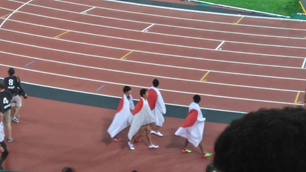
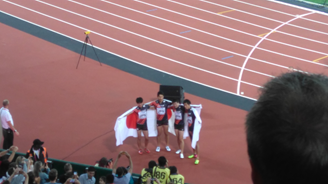
The second report is about the Noh Training Project held at Royal Holloway, University of London, located in Egham.
The main organisers of the project were Dr. Ashley Thorpe who teaches at the Drama Department at Royal Holloway and Ms. Laura Sampson, who helped run the project along with Dr Thorpe. They are both Noh practitioners as well. This project has been going since 2011. At the beginning, it was held at Reading University where Dr. Thorpe taught. Then, it moved to Royal Holloway as Dr. Thorpe had moved to Royal Holloway.
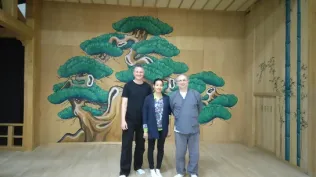
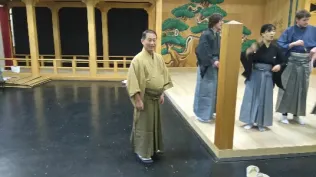
The main pillars of the project were the Noh Master from the Kita School, Matsui Akira Sensei and Richard Emmert Sensei, who travel from Japan every year to teach at the project. Both teachers are passionate about spreading Noh widely around the world, and have been giving workshops, and been involved in many projects and collaborations in Europe, Asia, USA and Canada.
Matsui sensei become independent as a Noh Master in 1967. He visited America and Canada as a cultural ambassador in 1972. After that, he began to teach Noh at American universities and other cultural centres. In 1990 Matsui sensei and Emmert Sensei visited SOAS as visiting instructors and taught Noh to SOAS students. Since then, Matsui sensei has given workshops around the world. In 2016, he was awarded an Honorary Doctorate from Royal Holloway, University of London for his contribution to the promotion of culture. In Japan he holds the title, “The general holder of Important Intangible Cultural Property”.
Richard Emmert Sensei first visited Japan in 1970 where he studied Japanese culture including Japanese History. After finishing his university studies in the USA, he studied traditional music at the Music theory section of the Music Department of the Tokyo University of the Arts. In the 1980’s he started an English Noh project, which took the idea of combining Noh music structure with English lyrics. In 2000, he formed an English-speaking Noh theatre group “Theatre Nohgaku”. The first teacher Emmert sensei learnt Noh from was Matsui sensei. Emmert sensei got a certificate in teaching Noh from Kita School in 1991. Dr. Emmert is currently teaching at Musashino University, Literature Department.
The fantastic point about learning Noh at Royal Holloway is that it has its own Noh stage. Mr. Handa who is Japanese donated the funds with which the theatre was built and it is named the Handa Noh Theatre.
There were two groups, beginners and intermediate/advanced, involved in the project. The beginners took part in a two-week intensive course and learnt four repertoires in singing and dancing, which for this year’s class were “Funabenkei”, “Shojo”, “Tamura” and “Gekkyuden”. Apart from singing and dancing, the students also learnt to play instruments; Taiko, Otsuzumi, Kotsuzumi and flute. The intermediate/advanced class started later in the second week of the project and the students learnt the dancing and singing of new pieces at their own pace. People could also just join in for the weekend and a few also came just to observe.
The beginners learnt the basic dancing forms, starting with Suriashi (sliding step), Shikake, Hiraki and Sashimawashi. In singing, the students practiced singing loudly following the tutor’s instructions.
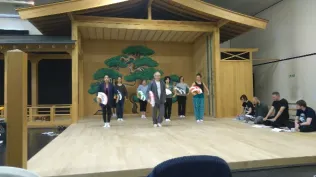
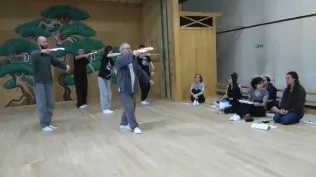
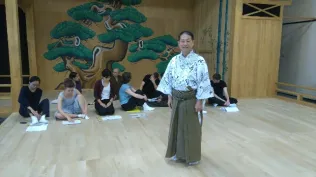
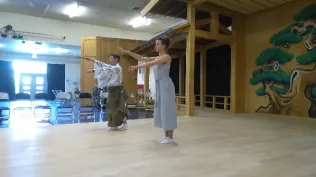
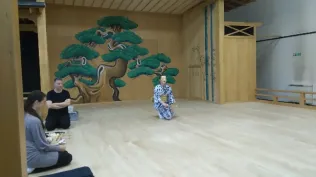
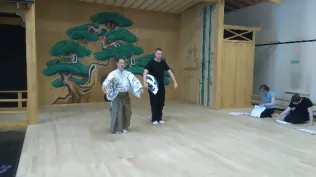
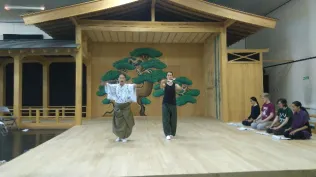
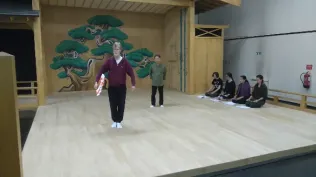
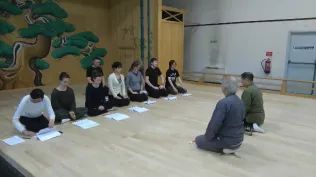
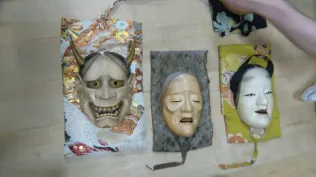
There were various types of people on the course. A woman from Switzerland is a contemporary dancer working on Noh; an English lady works as a freelance video/theatre practitioner; a Japanese lady is studying the techniques of repairing and maintaining old documents; a young male student from the North of England is in the middle of writing a play combining Noh theatre and Rakugo (Japanese Traditional Comedy story telling); a Rumanian lady who is fascinated by Japanese culture is a medical doctor; a Chinese lady from Hong Kong has a PhD in psychology and teaches English; a young male student studies drama at Queen Mary, University of London; an English lady who performs as a Geisha entertainer at events; a Spanish man who is a dancer; an English man who studies at Cambridge and has a strong interest in various forms of performing arts. As you can see, they were all very different which made for a very interesting course.
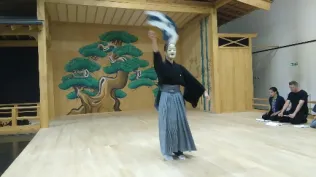
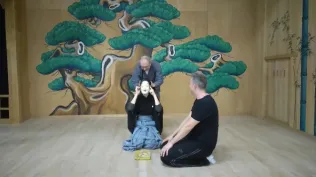
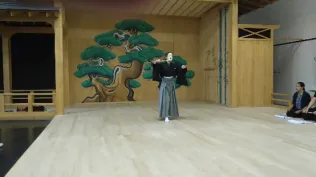
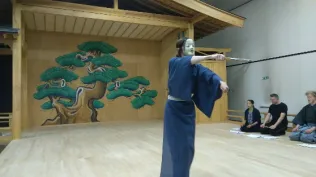
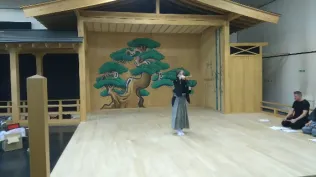
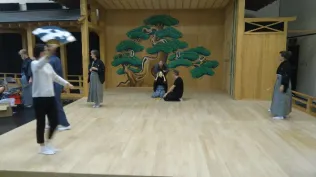
There was a students’ performance in the afternoon of the final day of the project. The students each chose their favourite piece to dance, joined by four to five students and teachers at the back of the stage who sang to accompany the dance.
It is interesting that when the students wore the formal costume of Montsuki Hakama (Kimono with emblem and Hakama trousers), their mannerisms changed and they looked like real Noh performers. All the Noh students gave a great performance in both dancing and singing.
I was moved witnessing the process of Japanese culture starting to permeate out to a larger audience. I am also excited about the idea that this circle of interest will get bigger and wider.
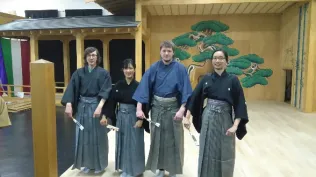
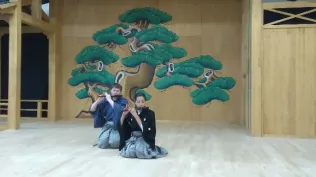
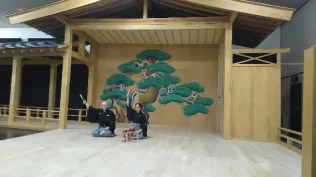
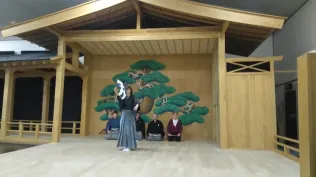
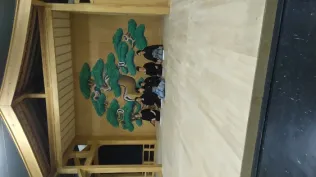
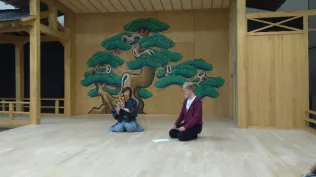
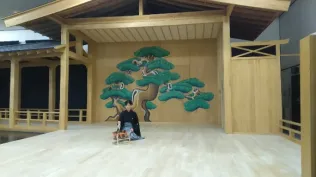
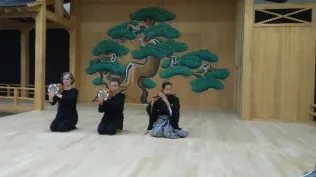
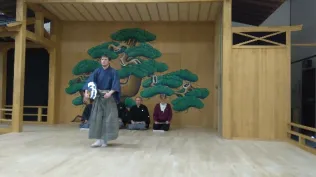
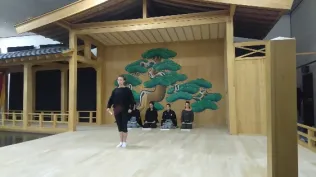
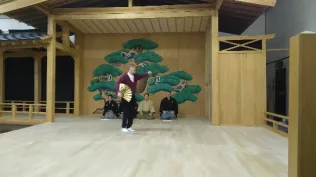
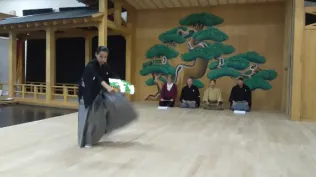
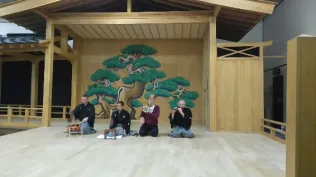
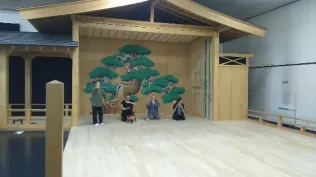
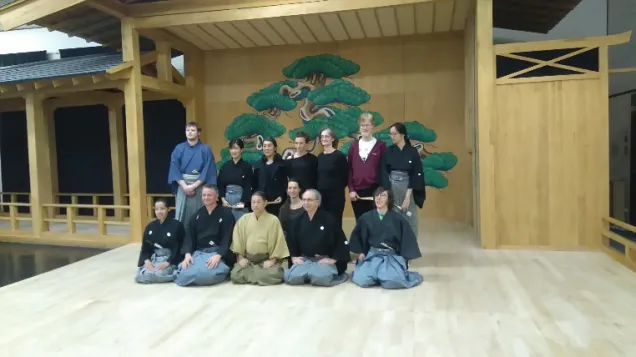
July Activity Report
3 August 2017
Global Japan Office Coordinator
Taguchi Kazumi
For July’s report, I am going to write again about events related to the British Museum Hokusai Exibition.
In my previous report, I featured an event designed for the members’ night. This time, the museum opened until late in the evening for the general public with many events to see and enjoy.
One of the demonstrations was “Chindon-ya” (Street Advertiser). Chindon-ya was presented as this occupation was started in the Edo period. The event began in the Great Court and featured make-up and the dressing of a kimono for a Chindon-ya lady. A huge crowd watched with enthusiasm the process of preparation.
After finishing the preparation, it was time for the procession inside and outside of the museum. The sound of Edo culture, Chindon chindon, echoed in the sky of London. Only the good old British Museum is capable of putting on such a cool show.
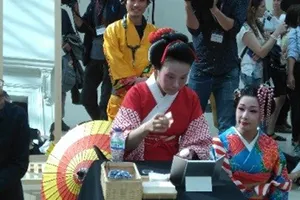
Chindon-ya lady demonstrating maku-up.
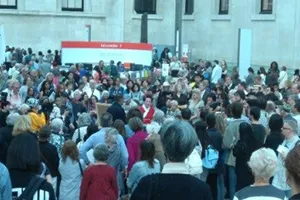
The audience at Great Court
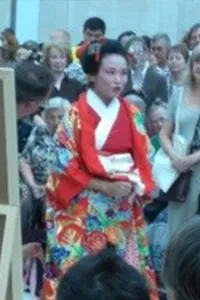
Dressing kimono.
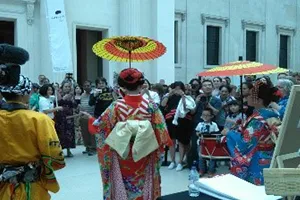
Ready for the procession
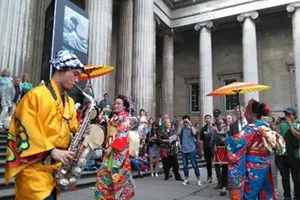
Marching outside of the Museum building in the Front Court
On the corner of the Great Court, there was a workshop where visitors were challenged to make a wood print of their own. The museum supplied the wooden board and pencil, and participants carved for themselves. The finished artworks were placed on show at the Hokusai wave presentation spot nearby.
The lady who was responsible for dealing with the participants of the workshop wore a dress with a Hokusai wave pattern, and you felt her enthusiasm for Hokusai. In my opinion, you get the impression that British people are in general rather reserved, however, when they take to something they go absolutely crazy about it.
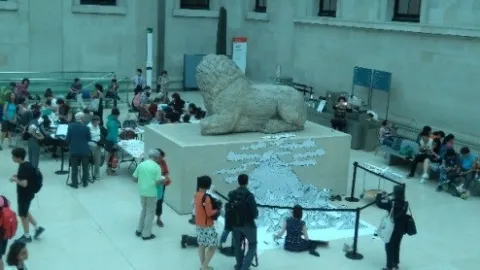
Workshop and Hokusai wave presentation space
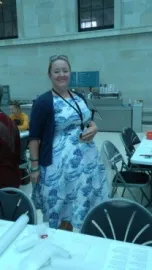
A museum lady with Hokusai print dress
Another event was Koto playing on the staircase of the Great Court. After a while, a group of people gathered together dancing and ascending the stairs whilst moving. I think they were attempting to imitate Hokusai’s Great Wave, they certainly looked interesting.
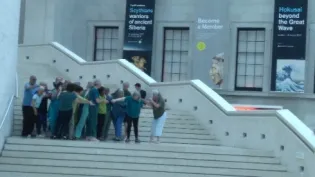
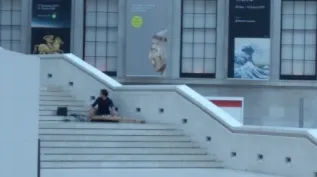
Once again, a Tsugaru shamisen player, Ichigawa Hibiki, and a singer, Mochizuki Akari, presented their music and singing, promoting traditional Japanese culture. This time, they played in the Japanese Gallery surrounded by fine artworks from Japan. It is a fantastic that the museum can provide such a special opportunity for so many people, something which is difficult to organize even in Japan. The audience was mesmerised by the powerful sound of Tsugaru shamisen, beautiful singing and the special atmosphere provide by a fine collection of Japanese art.
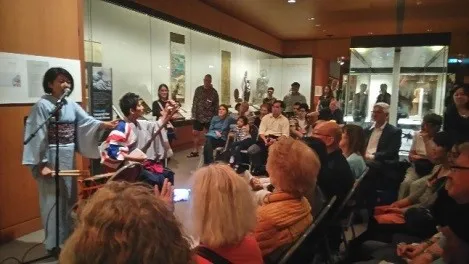
Akari Mochizuki and Hibiki Ichikawa presenting traditional music at the Japanese gallery
The final event to introduce is the Sake tasting corner which was held on the opposite corner from the workshop. People wearing Kimonos served us free samples of Sake from many different regions of Japan. Recently there has been an increase in the number of British people drinking sake, and it has become part of the popular food culture of Japan along with Sushi.
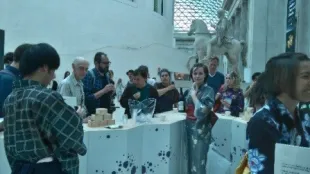
Sake tasting corner
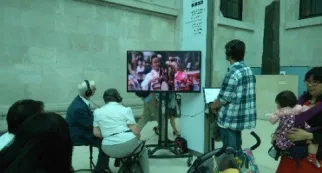
People listening and watching Chindon-ya
A popular mascot of the Hokusai exhibition is a white bob hair duck wearing a pinkish red kimono. The museum launched the Samurai duck at the time of the Shunga exhibition a few years ago and it now makes a great partner for the new duck. The British Museum doesn’t charge an entrance fee except for special exhibitions, it is run by donations from people and the profit they make from the museum gift shop. The museum shop has a website to sell on line as well. The museum makes a great effort to make attractive goods in order to maintain their policy of free entry.
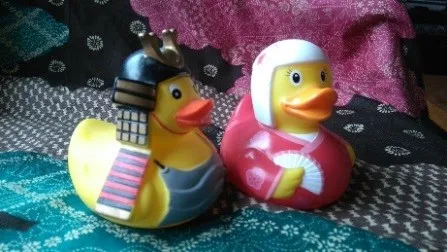
White bob hair with pinkie red kimono duck is launched at Hokusai exhibition.
I take my hat off to the enthusiasm, passion and great effort of the British Museum for livening up the Hokusai exhibition. The British Museum yet again organized an exciting event to introduce Japanese culture to visitors with many activities which everyone can enjoy. I really respect the museum and fell in love with it again.
July was the graduation season. I feature below a couple of shots taken on graduation day at the SOAS campus. The wearing of a gown and hat create an atmosphere of ceremony and occasion.
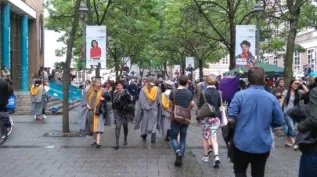
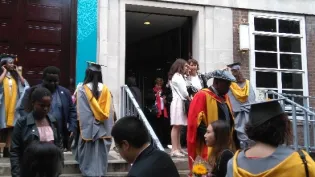
Graduation day at SOAS campus
June Activity Report
3 July 2017
Global Japan Office Coordinator
Taguchi Kazumi
For the June report, I would like to write about three events.
At the beginning of the month, there was an opening of a new exhibition at the British Museum titled “Hokusai, beyond the great wave”. It is a well-organised exhibition providing free family activities and talks to accompany the exhibition. To launch the exhibition an event was specially organised for museum members. It took place in the evening after the museum had been closed to the public. Members were able to freely walk round the museum and enjoy the exhibition at their leisure. A Tsugaru shamisen player, Ichikawa Hibiki, whom I introduced in the April report, and a singer, Mochizuki Akari, were performing in one room in the museum to provide Japanese sounds in keeping with the event.
The Hokusai exhibition displays Hokusai’s works in chronological order. The sketchbooks showing Hokusai’s drawings in which he captures the movement of people and animals were just magnificent. These sketchbooks are called Manga, from which we get the modern-day term Manga, meaning a comic book. One of his most famous paintings, Red Fuji, is exhibited along with Pink Fuji, both of which are fascinating. The exhibition introduces us to Hokusai’s religious viewpoint as well as the spiritual and artistic quest which heavily influenced his later works.
This exhibition has been supported by a joint research project between SOAS and the British Museum titled “Late Hokusai: Thought, Technique, Society”. It is led by Timothy Clark from the British Museum and Dr. Angus Lockyer from SOAS.
The subject matter of the artworks is based on quintessential Edo culture. However, the use of perspective and the vivid blue colours in the pieces are the result of western influences introduced in the late Edo period. They reflect the rapid transformation from a feudal to a modern society which was taking place in Japan at the time.
This exhibition presents Japanese culture in the best possible way in a subtle manner which also manifests the broad-mindedness of British culture and its sophisticated approach to art appreciation. Surrounded by these magnificent Hokusai paintings, I had the sensation of being more in Japan than when I actually am in Japan!
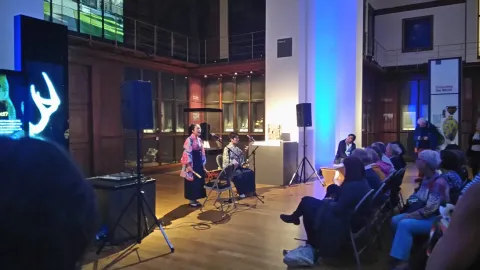
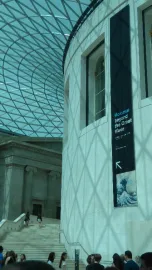
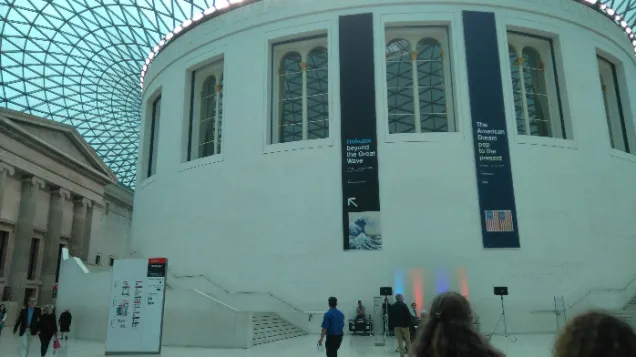
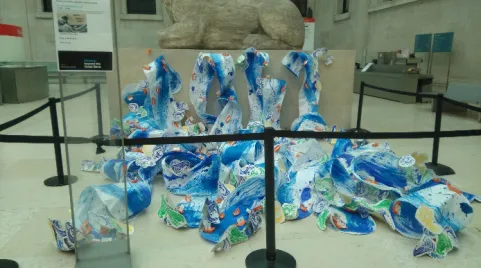
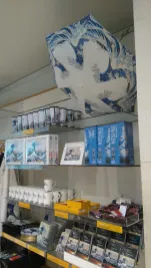
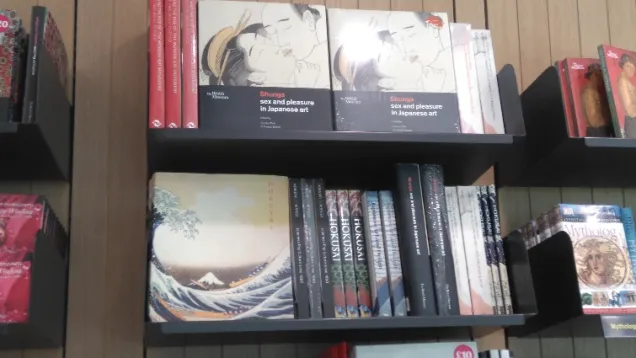
The second report of the month is about a Korean cultural event at SOAS held at the end of the academic year. The event was organised by students who are members of one of the many Korean cultural societies, such as the Drumming Society, the Gayageun Society, the Dance Society, the Sori Society and the Wind Society. At this event, the students give a performance in which they demonstrate what they have learnt during the year.
There is one student from TUFS learning Gayageun, and I took some photos of her as a souvenir of her time at SOAS.
Although it is organised by the students and many of the teachers are students and researchers, they are all professionals in their field and the quality of the event is of a very high standard.
The audience joined in the dance and games at the end bringing the event to an exciting climax.


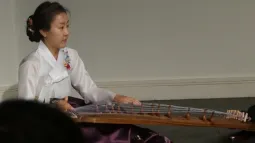
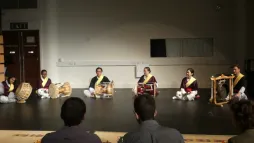
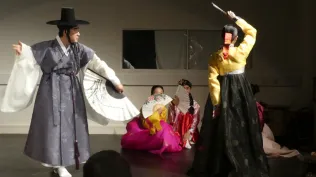
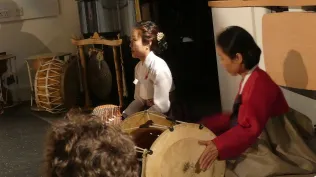
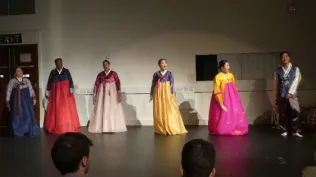
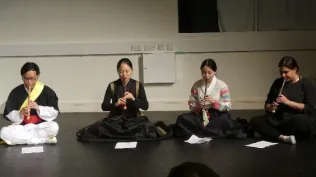
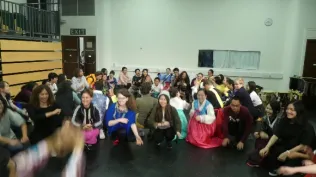
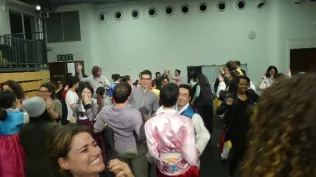
The third report of the month is on the Okinawa Day, which takes place annually in London. This event features Okinawan folk and classical music, Amami Oshima’s folk music, the Okinawan classical tea ceremony called Buku buku cha, various local Karate groups’ demonstration, and the Eisā drum and hand dance.
The originator of the event is Dr. David Hughes, whom I introduced in last year’s report on the SOAS Minyo Group who perform Japanese folksong. Dr. Hughes planned the “Okinawa Eisā Project” from 2004 to 2005 when he was head of the Music Department at SOAS. The aim of the project was to invite the Sonda Eisā team and Okinawan musicians to the Thames Festival which is organised by the Mayor of London.
Two instructors were invited for a one-week workshop to teach drum-dance and hand- dance. This course was held at SOAS two months before in order to prepare for the event. During this workshop, a local London Eisā team was formed in order to support the Sonda Eisā group from Okinawa in their performance at the Festival.
It is fantastic that despite members changing over the years the tradition of Okinawan culture has carried on until today as a local event in the heart of London. The group that grew out of the visit of the Sonda Eisā team is now called the London Okinawa Sanshinkai.
The venue is near the banking quarter, and it has been developed in order to create a space where people can casually gather together and enjoy the atmosphere. The space has been used to promote world culture, and as well as the Okinawan memorial event many other events take place here throughout the year.
It is an outdoor occasion, and people are free to walk round or sit down. The audience responds very positively while listening to the music and watching performances. There are children performing in the Eisā group, and many of them are girls. They perform a powerful drum dance, a clear display of ‘Girl Power’!
It is a very special experience listening to the sound of the Sanshin, the singing, powerful drumming and drum calls of Okinawa in the centre of London. It makes me feel Furyu.
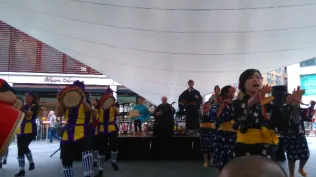
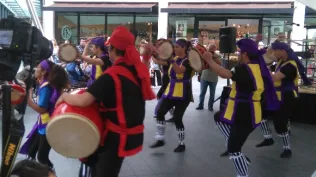
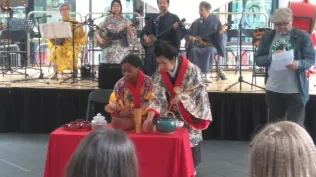
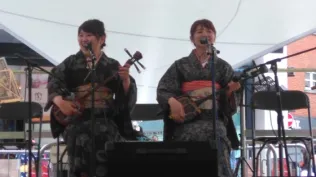
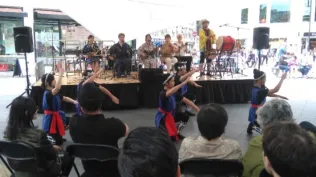
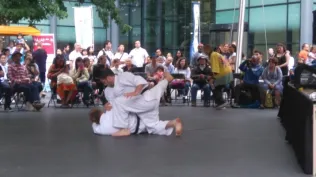
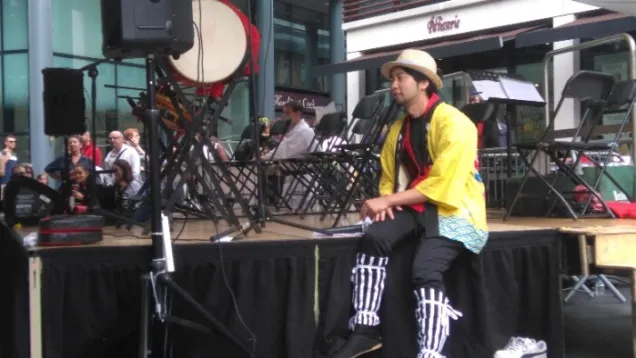
May Activity Report
4 June 2017
Global Japan Office Coordinator
Taguchi Kazumi
I would like to make a report about a talk given by Dr. Damian Flanagan at the end of April which took place in Manchester in the North of England.
Dr. Flanagan gave a talk at TUFS last December titled “From “Kokoro” by Koizumi Yakumo to “Kokoro” by Natsume Soseki”. He is a leading research scholar in Japanese Literature, and is a specialist in Soseki’s work. He translated Soseki’s “Tower of London”, and has written introductions for the translations of “Three Cornered World”, “The Gate” and “Kokoro”. Dr. Flanagan has also given many talks at the Daiwa Foundation.
http://www.damianflanagan.com/DJFlan_E_publ.html
The event was a collaboration between The Japan Society, which has been contributing to the promotion of and understanding of Japanese culture by organising many Japan related events, and JET ALUMNI, which was formed by British University graduates who went to Japan to teach English and who have since returned and are now living in the UK.
The title of Dr. Flanagan’s talk was “The Dark Secret of Natsume Soseki”. It is a very interesting title no matter whether you are a Soseki specialist or not. The venue for the event was a very impressive, renovated, nineteenth-century mansion which provided a very homely atmosphere. We felt as if we had been invited into someone’s sitting room. Dr. Flanagan began his talk when the venue was filled with the members of Japan Society and JET ALUMNI.
Dr. Flanagan began his talk explaining a little of the history of the house called Sommerville, which was the venue for the event. The mansion had belonged to Lieutenant General Harry Smith who was active in the first part of the nineteenth century in the British Army.
https://en.wikipedia.org/wiki/Sir_Harry_Smith,_1st_Baronet
Dr. Flanagan said that the building was in very bad condition when they began the renovation. It was hard to imagine the run-down condition of the past, as the building has now been transformed into an immaculate condition.
After the history of the house, Dr. Flanagan moved on to the day’s main subject. He began talking about Lafcadio Hearn who was a Japan specialist and known as Koizmi Yakumo.
Lafcadio Hearn taught English literature at Tokyo Imperial University before Soseki and was replaced in his position by Soseki after he came back from his study period in London where he had been sent by the government.
Dr. Flanagan told the audience that Lafcadio Hearn wrote a book titled “Kokoro”. Soseki also later in his career titled one of his novels “Kokoro”, consciously choosing the same title as Hearn. We don’t know the exact reason why Soseki named his novel “Kokoro”, but it is a very interesting point that Dr. Flanagan raised about the same title by two different authors. I believe Dr. Flanagan went into this in more detail when he gave a talk at TUFS last December.
The conclusion to the main theme of Dr. Flanagan’s talk, “the dark secret of Soseki”, was that it was necessary for Soseki’s best friend, Shiki to die in order for Soseki to flourish fully as a literary writer.
After quitting university, Shiki’s talent flourished at this relatively early stage in his short life. He began a new movement in the Haikai world, established a literary journal, Hototogisu and became an editor of that magazine. He also became a journalist and went to China to cover current events.
According to Dr. Flanagan, Shiki’s existence became an obstacle to Soseki becoming a literary artist. Soseki was liberated and felt free to write creatively only after Shiki’s death.
It is a fresh view point regarding the friendship between Soseki and Shiki. In fact, it is true that Soseki’s talent as a literary writer flourished after Shiki’s death. On his return from London he experienced a period of psychologically instability. During this time Takahama Kyoshi who was a student of Shiki and succeeded him as editor at Hototogisu suggested Soseki write something for the journal. In answer to his request Soseki wrote “I am a cat” and the rest as they say, is history.
Another point of view in my opinion is that Soseki might have carried on working as an English literary specialist, and not have got involved in composing Haiku, Kanshi and writing novels, if he hadn’t been influenced by his best friend, Shiki.
I am looking forward to Dr. Flanagan keeping us provided with many more interesting views and opinions as he continues his research in Japanese Literature.
Finally, I would like to pay my gratitude to JET ALUMNI and THE JAPAN SOCIETY for letting me participate in such an interesting event. Thank you very much.
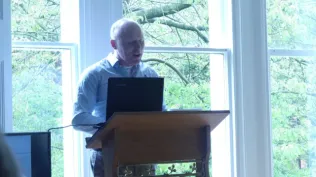
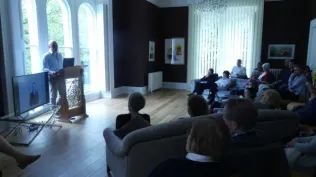
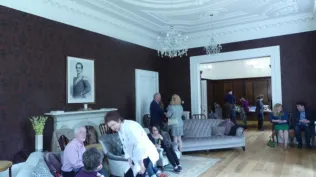
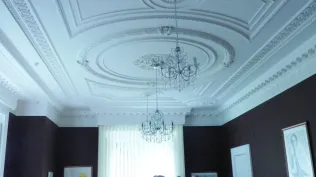
April Activity Report
4 May 2017
Global Japan Office Coordinator
Taguchi Kazumi
As we know, April is famous for being the season of the cherry blossom. It seems that the arrival of the cherry blossom front was later than usual this year in Japan. On the contrary, London had a rather early season for the opening of the cherry blossom. I would like to write about the theme of the Cherry blossom in the UK.
There are a number of squares in the area of Bloomsbury where SOAS is situated. One of them is called Tavistock Square. There, you can find a cherry blossom, which has huge, deep, pink petals. When you get closer and focus on its root area, you find a memorial plaque. On the plaque, it says that the tree was planted, on 6 August 1967, in memory of the victims of Hiroshima by the Mayor of Camden.
Every year in the summer on the weekend nearest to the Atomic Bomb Memorial Day of Hiroshima, people who wish for peace gather together at this spot. People pray to comfort the spirit of the victims of the atomic bomb, and make speeches to remind themselves not to forget the hardships and existence of Hibakusha (the survivors of the bomb), and that we as human beings should never repeat the same mistake again. This cherry blossom plays a central role in the event as a symbol of peace.
On the day I visited the square to take some photos, I happened to see many Origami cranes placed around the tree. The Paper cranes scattered on top of the bed of cherry blossom petals looked mesmerisingly beautiful. About a week before, there had been a terrorist incident in the centre of London; a policeman was stabbed and lost his life whilst on duty in front of the Houses of Parliament. A sad reminder of how this square is an important space for people to express their feeling that no matter what happens, people will never tolerate violent action and will continue to work for peace.
In the centre of this square, there is a statue of Mahatma Gandhi who dedicated his life to the independence of India through none violence and none subordination. The statue of Gandhi always has a garland around its neck and a lit candle underneath.
Tavistock Square is the place where people from London send a message for peace quietly out into the world.
The next block to Tavistock is Gordon Square. It is situated on the north side of SOAS, and there, students and the general public gather to have a moment of peace and of fresh air. I found one small tree which looked like a Someiyoshino, standing on its own bravely showing a sense of dignity. It reminds me of the great literary artist, Natsume Soseki, who visited London over 100 years ago and stayed in London for about two years. Soseki said in “My Individualism” that he found his own value called ‘On my own terms’ through living alone in London.
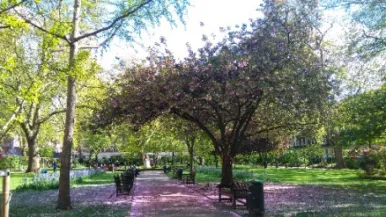
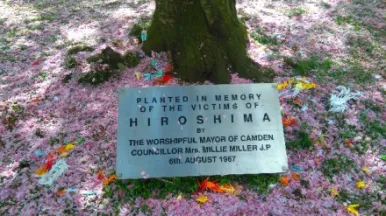
The Cherry Blossom tree in Tavistock Square
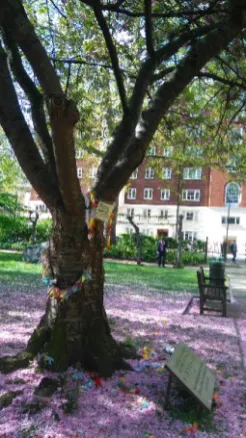
The Cherry Blossom tree in Tavistock Square
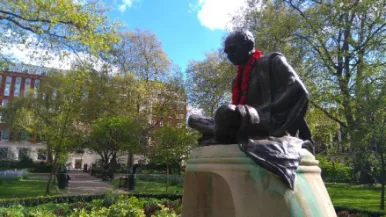
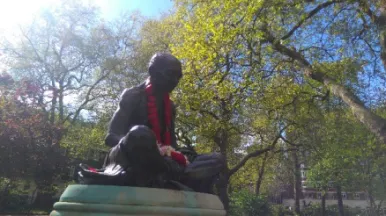
The statue of Gandhi
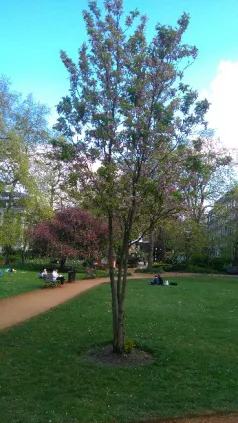
The Someiyoshino at Gordon Square, with SOAS in the background
Another image of Sakura (cherry blossom) is the music band called No Cars, whose members consist of three Japanese women and one English gentleman. I went to see their final concert before they were about to take a long break.
Their name is No Cars, and they introduce themselves as farmers, as ‘No Cars’ sounds similar to ‘farmer’ in Japanese. At a glance, they look as though they are eternal seventeen-year-old girls. However, they play their instruments very well, and they are firm in their minds and attitude just like cherry blossom.
The band was formed in 2007 and began to play in public from 2008. The members of the band have changed over the years but they have had their present lineup since 2014. In total they have made three albums. I asked them what was the most important thing for them in terms of their musical performance. The answer was that they want to be masters of buffoonery, something which acknowledges the contradictory nature of human kind. They want to be clowns because if they have to be serious all the time, life becomes oppressive and dangerous.
They are close friends and enjoy playing in the band together, as they can experience and try out things that they would never do individually.
The members of No Cars are the founder of the group, Haruna Komatsu on lead guitar, vocals, clarinet, saxophone; Takako Iida on bass guitar and vocals; Tomoko Komura on Keyboards and vocals; and Candy a.k.a Will Joh on drums
They are all very talented individuals and have skills beside playing in No Cars, i.e. Playing Japanese Taiko, working with theatre music and production, acting, interpreting, introducing Japanese Culture, researching on Aroma Therapy. They are strong and powerful Japanese women of the twenty-first century.
The venue was packed with No Cars fans keen to catch the band before they went on a long break. No Cars also had a supporting band called Bing Selfish & the Windsors, which is a group of experienced and talented musicians. No Cars performed two sets on the night and thoroughly entertained their fans.
I hope No Cars come back before too long from their break as they are a very enjoyable experience and fun.
Next month, I will be writing about a talk given in Manchester by Dr. Damian Flanagan who is a Soseki specialist.
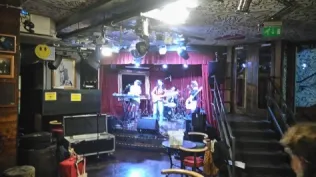
No Cars, sound-checking
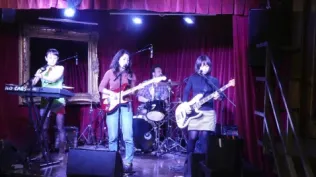
No Cars, sound-checking
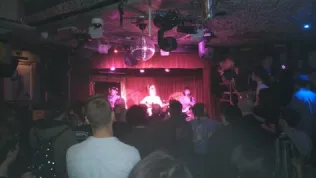
The venue was packed with fans
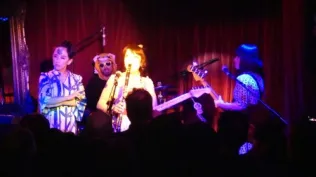
Having an amusing time with Tomoko doing her David Bowie act
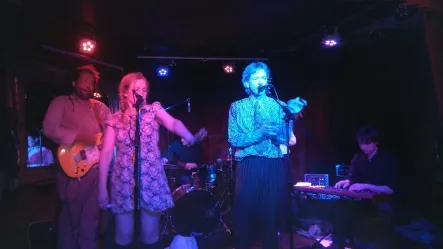
Experienced musicians, Bing Selfish & the Windsors supporting No Cars
